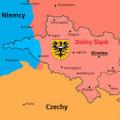From the side of the South Atlantic Maximum, monsoon winds blow towards the heated continent, bringing rains to the southeastern edge of the Brazilian Highlands and the La Plata lowland. Most of the west coast, from 30 ° to almost the equator, is influenced by the eastern periphery of the South Pacific Maximum and receives no precipitation. Only a stretch of coastline north of Guayaquil Bay is affected by equatorial air masses and is watered by abundant rains.
On both continents, these areas are dominated by the creosote bush. The largest surpluses in South America occur along the southern coast of Chile. In North America, the highest surpluses occur in the Pacific Northwest. In North America, the driest regions are found in the southwestern United States and northwestern Mexico. California's Central Valley and much of the intermontane west have significant deficits. The central pasture area has a moderate deficit in the semi-arid western part, ignoring the deficit in the sub-humid east, where meadow surfaces interact with deciduous forest.
Humid oceanic air comes to the extreme south of the continent from the west, the Pacific coast and especially the western slopes of the Andes receive a large amount of precipitation, and the Patagonian Plateau, located under the cover of the Andes and washed from the east by the cold Falkland Current, becomes the center of formation of relatively dry continental air masses of temperate latitudes ...
The forested areas of the Rocky Mountains, the eastern United States, and parts of Canada included in our study area are free from water scarcity. Driest areas South America are located in the northwestern part of Argentina and on the northern coast of Chile. Other dry areas are found in central and southeastern Argentina. Unlike North America, grasslands do not fall into the forest. Changes in seasonality were expected to be nothing or very small. All three models predicted an increase in temperature in North America than in South America.
Climate change has increased the proportion of areas on both continents experiencing annual water shortages. In North America this share doubled from 11 to 22%, and in South America from 28 to 41%. Deposits increased and were adjacent to existing deficit areas. The main effect of climate change has been the expansion of existing dry areas.
In July the entire northern part of the continent is under the influence of humid equatorial air brought in by the southwestern monsoon, and no less humid tropical marine air coming from the Atlantic Ocean (see Fig. 9).
High pressure and dry weather prevail over the Brazilian Highlands as the tropical maximum of the southern hemisphere moves northward. Only the southeastern edge of the highland is affected by the southeastern trade wind, coming directly from the Atlantic Ocean, and receives a significant, albeit less than summer, amount of precipitation.
Since many plants are susceptible to the existence of any period of water scarcity, we performed additional analyzes to determine the magnitude of the periods of water scarcity. We did this by citing a deficit for all the months that there was a deficit. We will refer to this as the monthly deficit to distinguish it from the annual deficit discussed above. The calculation of the monthly deficit determines the same dry areas that were determined with the annual deficit, but does a better job of identifying areas of semi-arid grassland and scrubland.
In subtropical and temperate latitudes southern hemisphere dominates western transfer and cyclonic rains fall. Patagonia continues to be a center for relatively dry and cold air, which at times breaks through northward as far as the Amazonian Plain, causing significant temperature drops there (Figure 82).
Approximately 48% of the study area in North America experiences at least one month of water stress for some time during the year. Fifty-three percent of the study area in South America has at least one month of deficit of up to 500 mm.
Very dry areas in the southwestern United States and northwestern Mexico have intensified and expanded north and east. Northwest Argentina became drier and the extent of dry conditions expanded north and east. New, very dry areas became apparent in central and southern Argentina. The size of these areas varied depending on the model. In very humid areas of the Pacific Northwest in North America and on the southern coast of Chile in South America, water deficits persisted in the zero month. In addition, the monthly water shortage spread to eastern part North America into areas currently occupied by deciduous forests, indicating that the area may be vulnerable to vegetation change.

Rice. 82. average temperature air in South America at earth surface in July
Above central part Pacific coast from 30 ° S lat. almost to the equator, in July, as in January, southerly and south-westerly winds prevail, blowing parallel to the coast over the waters of the cold Peruvian Current. Low inversion levels prevent rainfall on the Pacific coast at these latitudes. Only on the northern coast, where the trade wind passes into the southwestern monsoon, receives a significant amount of precipitation.
These patterns of changes in monthly water scarcity indicate that some changes in the current distribution of ecosystem types may arise with climate change. While we recognize that these changes will occur at different rates, depending on the exact conditions and inertia in the vegetation to be displaced, our goal here is to match the new climatic conditions with the most likely potential ecosystem type. This assumes that ecosystem types track climatic zones.
In North America, both subtropical and temperate deserts will expand to the north and east of their present positions. The bottom line of the tree will move upward in the western mountain ranges... The subtropical desert conditions typical of southern New Mexico and western Texas will extend over vast plains to areas currently occupied by dry grasslands. Dry pastures, which are currently characteristic of the western part of the central pasture region, will spread to the east.
South America is located mainly within equatorial, both subequatorial and southern tropical climatic zones... In the extreme south, it enters the subtropical and temperate zones.
Equatorial climate zone in South America it covers the entire Amazonian lowlands (except for the eastern part and the extreme south), the adjacent parts of the Guiana Highlands and the Orinoco Lowlands, and the Pacific coast north of the equator. This belt is characterized by abundant rainfall and a uniform high temperature (24 ... 28 ° C) throughout the year. Annual precipitation ranges from 1500 to 2500 mm, and on the slopes of the Andes and on the Pacific coast, the amount of precipitation increases to 5000 - 7000 mm per year (Fig. 83).
Wet meadows in the eastern part of the pasture region will spread eastward, displacing deciduous forests. In the north, the meadows will extend into areas that are currently occupied by boreal forests. The most wet areas the Pacific Northwest will be severely affected by changes in water scarcity.
Climate change in ecosystems in South America will be similar in North America with some notable differences as a result of the size and shape of the area. Deserts will expand into areas that are now grassland. Subtropical deserts will expand much more than temperate deserts, and the result is likely to be a net loss of temperate desert. The bottom line of trees in Argentina and northern Chile will move upward.

Rice. 83. Average annual rainfall in South America
South America is a continent located in the Western Hemisphere of our Planet. It is crossed by the Equator line and divides this continent into two parts. One part (the largest) - belongs to the Southern Hemisphere, and the second (smallest) - to the Northern Hemisphere.
The climate database was kindly provided by Rick Lemans. We thank Martha Coleman and Tammy Bear for their help. Ellenberg X Wald in Pampa Argentines? Schultz J. Ecozones of the world. Soriano Deserts and semi-deserts of Patagonia. Delft, Netherlands. 15 pp. Walter X Vegetation of the Earth and ecological systems of the geobiosphere.
Associate Editor: Pablo Marche. The perspective of the sun, summer temperatures and sandy beaches Freezing temperatures and snowy streets, drives Americans to Central and South America in droves during North America's dreary winter months. V Southern hemisphere South America enjoys an exact inverse seasonal calendar as north, and equatorial Central America also has its own dry season during the North American winter. Just skip the festive season from Christmas to New Years and around Easter - the crowded times when people in the region go on vacation.
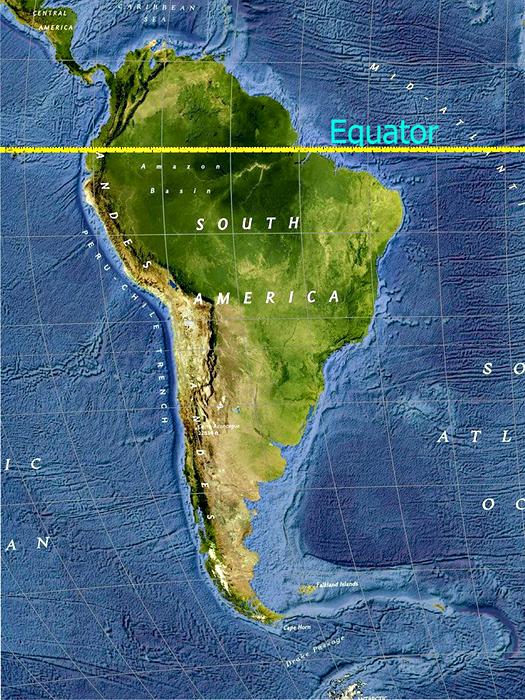
The mainland ranks 4th among the continents in terms of its area - 17 840 000 km². On its territory, including the adjacent islands, there are 15 states, three of which are dependent. By clicking on the link, you can see a detailed list of South American countries in the table with capitals and characteristics. The population is approximately 400 million.
While Central America enjoys tropical climate all year round, dry season is the most pleasant time to visit the region. At the beginning of the dry season, prepare for cool evening and morning weather. Outside of the dry season, in addition to humidity, travelers are faced with oppressive mosquitoes, heavy rain, tropical storms, and the possibility of hurricanes.
Tropical equatorial northern South America weather rules covering Colombia, French Guiana, Guyana, Suriname, and Venezuela. As in Central America, your the best choice to visit the region is to travel during the dry season and avoid the Christmas, New Year and Easter holidays. If you are planning to hike or visit high elevations such as the Venezuelan Angel Falls, travel during the rainy months in late fall to avoid trembling on mountain peaks during cooler dry season temperatures.
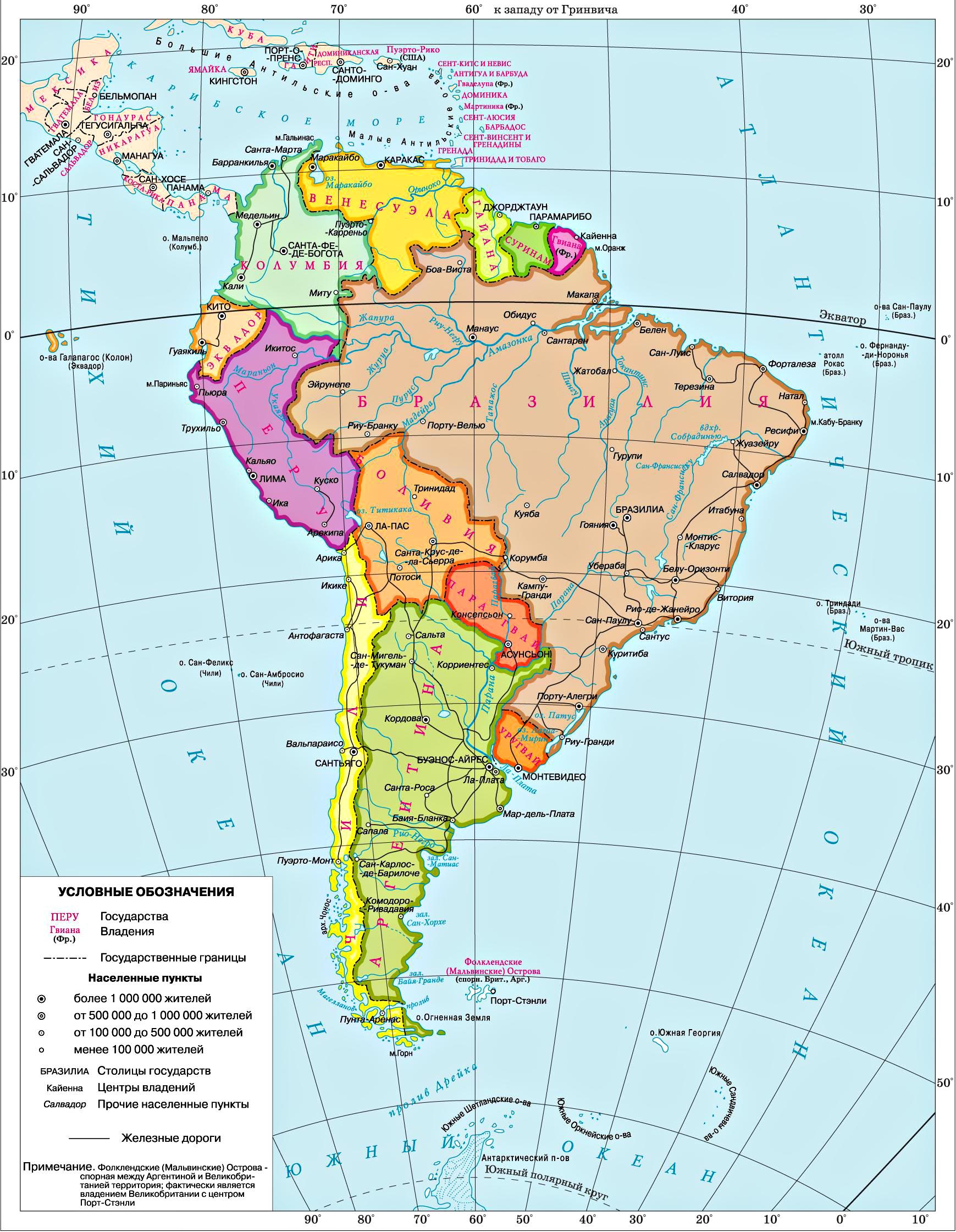
In the west, the continent is washed by the Pacific Ocean, in the east - the Atlantic Ocean, in the north - the Caribbean Sea, which is the border between North America and South America.
While you can unite Bolivia, Brazil, Ecuador, Peru, and even Paraguay under the umbrella of central South America, each country sits in or encompasses wide latitudes and climates. Throughout Central South America, the summer months, which usually reach well over 100 degrees Fahrenheit, are equally hot that you are better off visiting during the winter.
Consists of Chile, Argentina and Uruguay, South South-South America- the most difficult region to establish climatic conditions... Long, narrow countries rise from flat beaches to soaring mountains an hour's drive west or east. Unlike the tropical central region, southern countries South America lie mainly in temperate zone with dry summer summer With high temperature and cool winters. Drive to Patagonia in summer when warmer alpine temperatures create a pleasant trekking atmosphere.
Extreme points of mainland South America
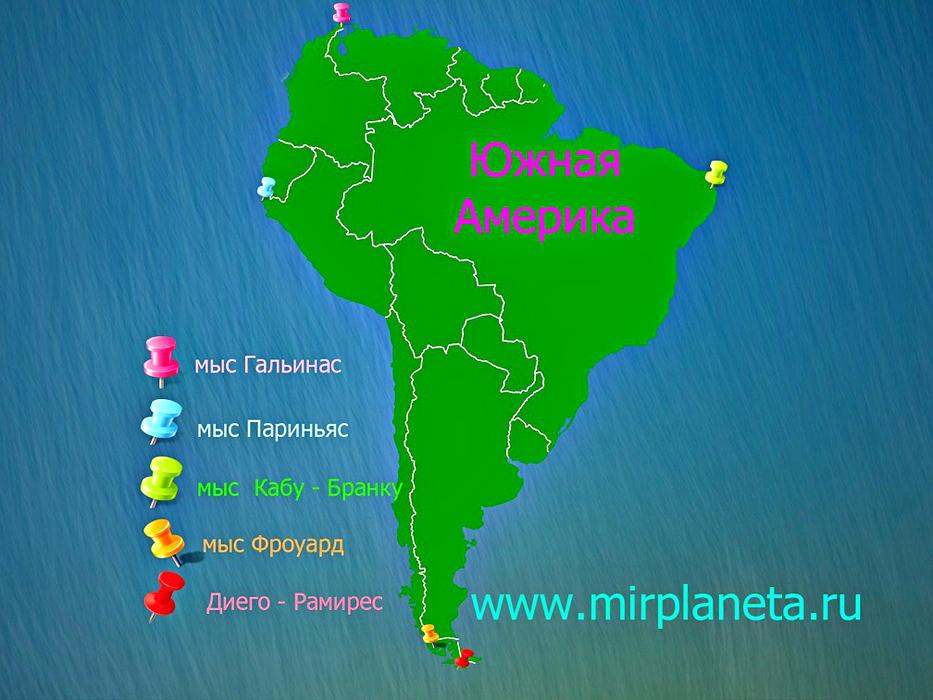
North Point - Cape Gallinas is located in Colombia on the Caribbean Sea.
South (mainland) point - Cape Froward is located in Chile on the Brunswick Peninsula on the shores of the Strait of Magellan.
South (island) point - Diego - Ramirez - the most southern point America and Chile, which consists of a group of islands covering an area of just over one square kilometer.
Have you noticed that during the summer, the orange rain group moves north from South America to Central America and Mexico?
- Have you noticed that one of the rainiest regions is closest to the equator?
- Where have you noticed drier regions?
- Then he moves south in winter?
The poles, in turn, are very dry. Learn more about Global Wind Systems. Which of the climatic zones on the above "globe" and on the map climatic zone you live? Do the same for the winter and breeding habitats of the migratory animal you are studying. What will he tell you about your animal's basic needs or ability to survive?
- Look at a globe or map and find your state or hometown.
- Describe the climate in these two habitats.
Western Point - Cape Parinyas is located in Peru.
The eastern point is Cape Cabo Branco, located in Brazil.
Relief of South America
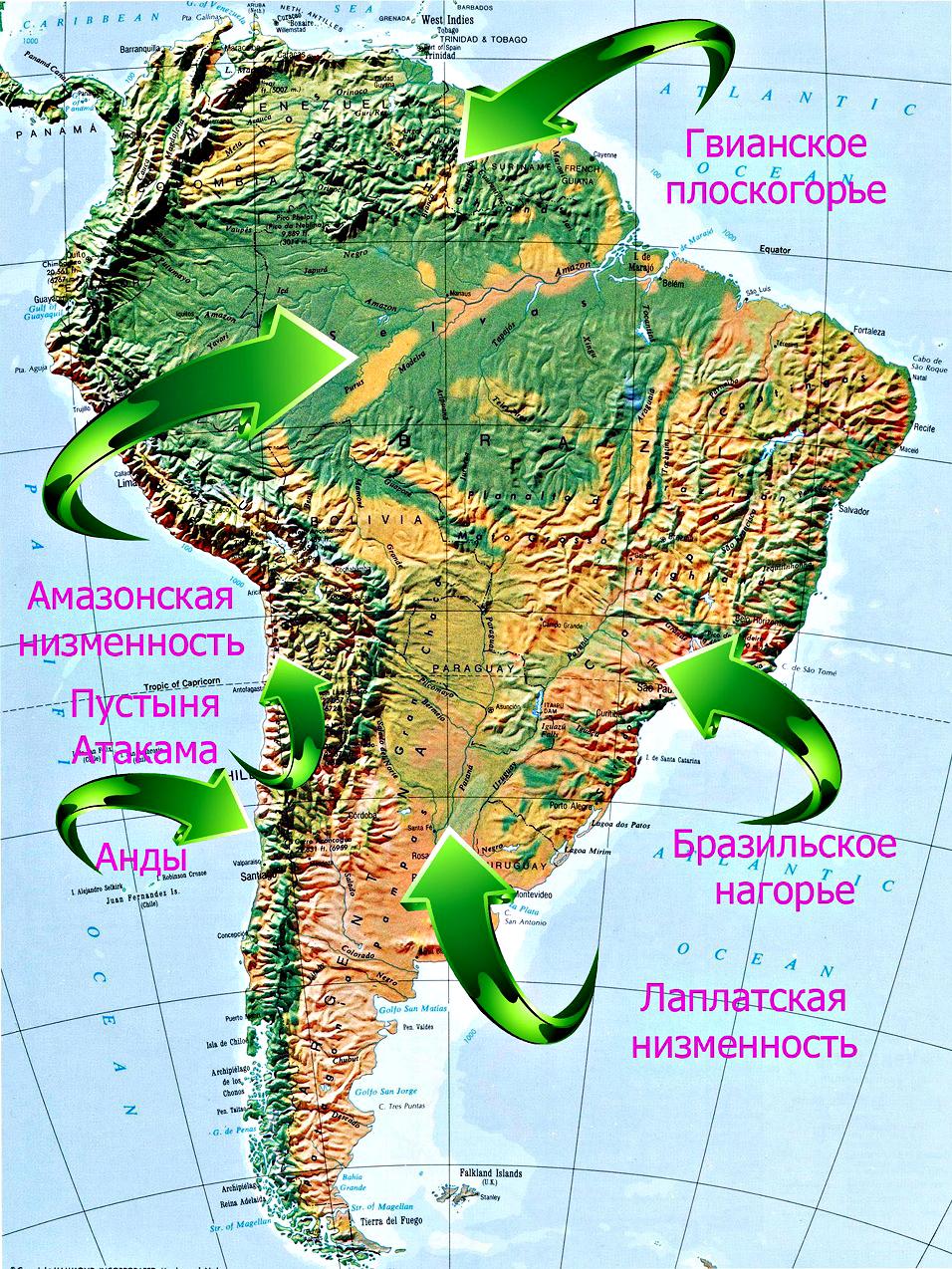
The continent of South America is divided in relief into the Mountainous West and the Plain East.
The Atacama Desert is located in Chile and is the driest place on earth. There are places in the desert where it rains once in several decades. The air humidity is lowest here. Of the vegetation, only cacti and acacias are found.
In many tropical and subtropical regions, precipitation fluctuates much more than temperature. In addition, as the earth tilts, direct sunlight, and in turn tropical rain, shifts from the northern to the southern tropics. Thus, these areas experience only two seasons: the rainy season and the dry season.
There are three main areas in which volcanoes are concentrated. The first of them appears between latitude 6 ° north latitude and 2 ° south, straddles Colombia and Ecuador and contains active volcanoes... This is the largest concentration of volcanoes in the world, and the most high volcanoes in the world. However, volcanic activity is low and geysers tend to erupt here. Also the most active is the third area of concentration of volcanoes. It is located in the central valley of Chile, mainly between 33 ° and 44 ° south.
The western part of the mainland consists of mountain system Andes, stretching across the seven states of South America, and the eastern of the plains. In the North there is the Guiana Plateau 1930 km long and 300-1000 m high.
In the east of the mainland, the Brazilian Highlands are located, with an area of about 4 million km2. It is home to 95% of the Brazilian population. Highest point this highland is the mountain - Bandeira. Its height is 2897 meters. Because of the huge natural diversity The Brazilian Highlands are divided by no three parts: the Atlantic, Central and South Plateau.
The climate in the Andes varies greatly with altitude and latitude, from hot regions to alpine meadow regions to the glaciers of the South. This whim is due to the extremely dry climate of the lower latitude. The Andes are a rich source of mineral deposits, in particular copper, silver and gold. In Venezuela, they are mined for copper, lead, oil, phosphates and salt; diamonds are found along the Rio Caroni. Colombia has the richest coal deposits and is largest manufacturer gold and platinum in South America.
Colombia is also rich in emeralds, containing the largest deposits in the world, with the exception of Russia. In Chile, the Andes are mined mainly for their large copper shops in addition to lead, zinc and silver. Bolivia has huge tin mines. The Andes are also a source of tungsten, antimony, nickel, chromium, cobalt and sulfur.
South of the Brazilian Highlands is the Laplat Lowland, on the territory of which there are states such as Paraguay and Uruguay, the northern part of Argentina, southern part Brazil and southeast Bolivia. The lowland area is more than 3 million km2.
The Amazonian lowland is a lowland covering an area of over 5 million km2. It is the largest lowland on our planet.
South America climate
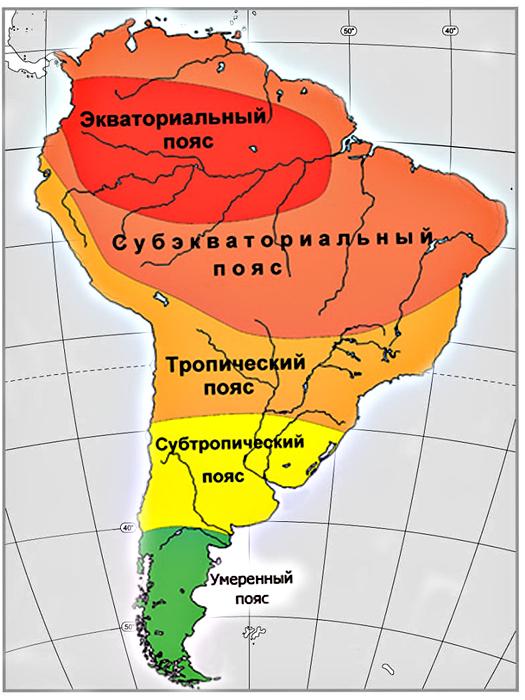
There are 6 climatic zones in South America: the North and South subequatorial belt, the Equatorial, Tropical, Subtropical and Temperate zones.
The climate of South America in most of its part is subequatorial and tropical, with distinct dry and wet seasons. Equatorial humid climate characteristic only for the Amazonian lowland. In the south of the continent, subtropical and temperate climate... In the northern plains the temperature is 20-28 degrees all year round. In the Andes, the temperature decreases with altitude. Even frosts are possible. On the Brazilian Highlands, the temperature in winter can drop to 10 degrees, and on the Patagonia plateau to zero degrees.
River systems of South America.
The following river systems are located on the mainland: Parana, Orinoco, Amazon, Paraguay, Uruguay.
The Amazon is the world's largest river in terms of its basin area (7180 thousand km²), formed by the confluence of the Ucayali and Marañon rivers. It is considered one of the seven natural wonders of the world. Brazil owns most of the basin. It flows mainly along the Amazonian lowland and flows into Atlantic Ocean.
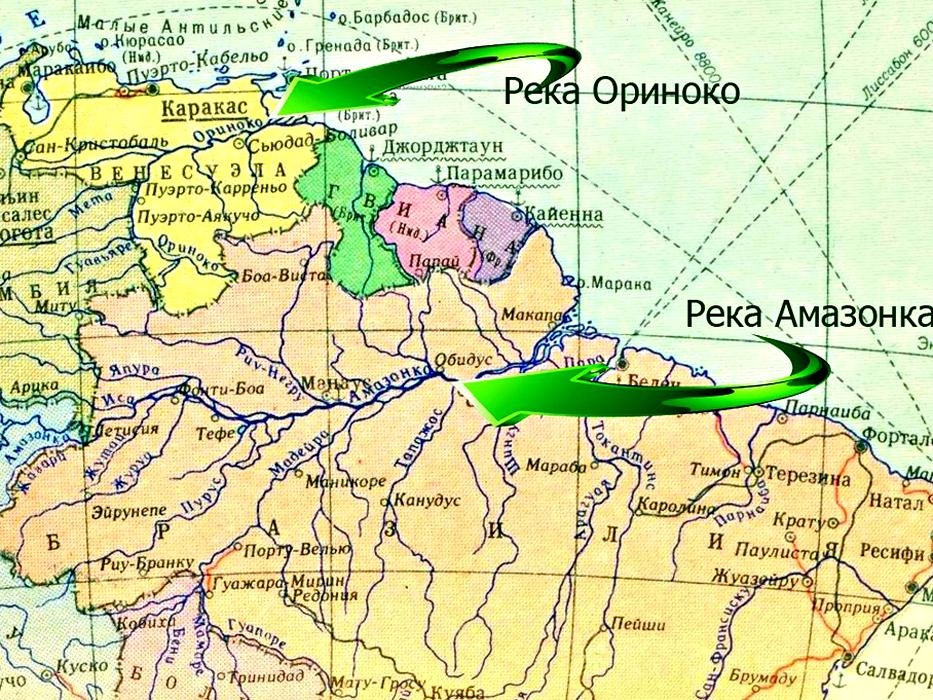
Parana is the second longest river on this continent, flowing in the southern part of the continent. It flows through the territory of Argentina, Brazil, Paraguay. Just like the Amazon, it flows into the Atlantic Ocean.
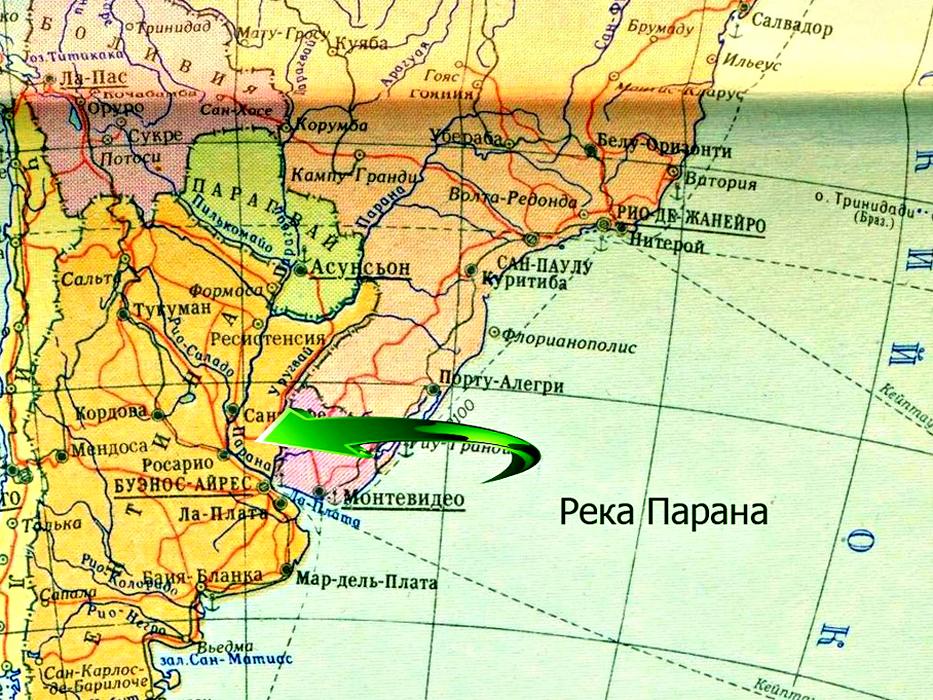
Paraguay is a river, is the right tributary of the Parana. Divides the Republic of Paraguay into Northern and Southern Paraguay, and also in its southern part is the state border between Paraguay and Argentina.
Uruguay is a river that originates in Brazil and is formed by the confluence of the Canoas and Pelotas rivers. It is the border between Brazil and Uruguay. Her river system is the main source of water supply for the country. The largest hydroelectric power plant in the country is also located here.
Orinoco is a river that flows through Venezuela and flows into the Atlantic Ocean. Its feature is the bifurcation of the river. The Casiquiare River is separated from it and flows into the Rio Negru River. This river is home to a white river dolphin or Amazonian and one of the largest is the Orinoco crocodile.
Lakes of South America
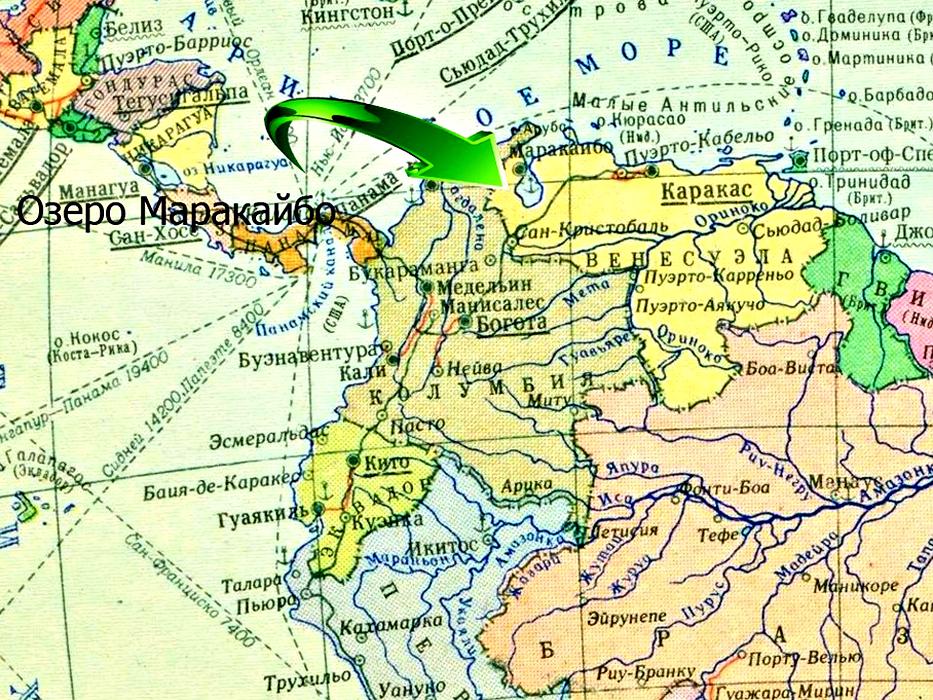
Maracaibo (translated as "Land of Mary") - large lake with brackish water, located in Venezuela. The depth of this lake differs significantly in its southern and northern parts. The northern one is shallow, and the southern one reaches (according to various sources) from 50 - 250 meters. This lake is also one of the oldest lakes.
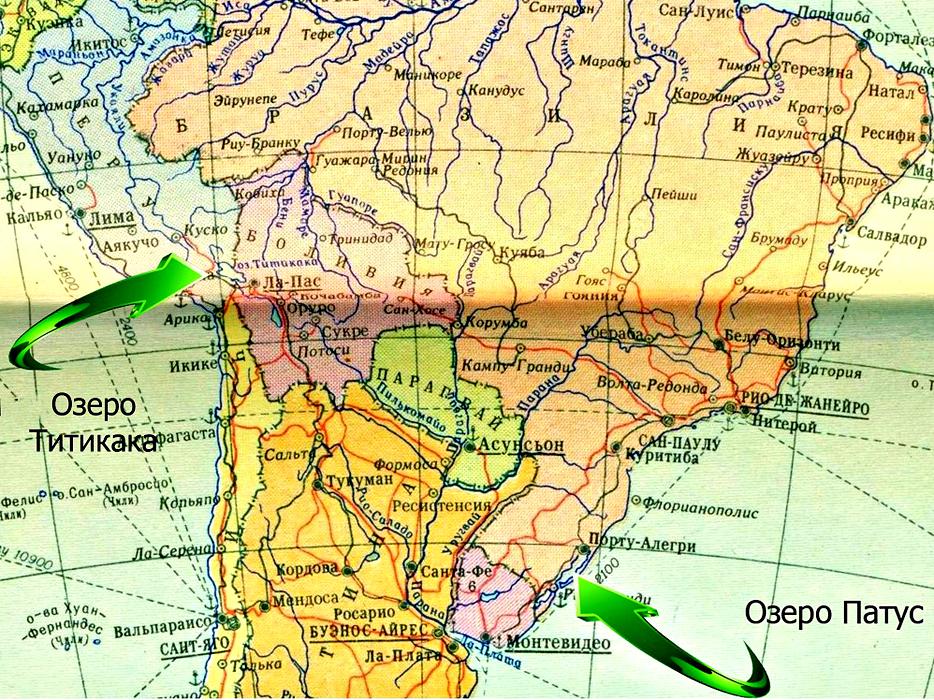
Titicaca (titi - puma, kaka - rock) - the most big lake in terms of fresh water reserves and second in area after Maracaibo. More than three hundred rivers flow into this lake. It is navigable. Archaeological research shows that the city of Wanaku is located at the bottom of the lake.
Patus is a lake located on the coast in Brazil. Its length is 280 km, and its width is 70 km. It is separated from the ocean by a sand spit 8 km wide. There are large hydroelectric power plants on it. Salt, fish and oil are mined here.
Flora of South America
Thanks to the warm climate and the huge amount of rainfall, the plant world in South America is very diverse. Each climatic zone has its own flora. A large area is occupied by the jungle, which is located in tropical belt... Here grow: chocolate and melon trees - papaya, rubber trees, various palms, orchids.
South of the jungle in equatorial forests deciduous and evergreen plants grow. A tree such as a quebracho grows here, which has a very durable wood. V subtropical zone vines and cacti can be found. Further, moving south, there is a steppe zone, where feather grass and various grasses grow. Behind this zone, deserts and semi-deserts begin, where dry shrubs grow.
Fauna of South America
The fauna of the mainland is as diverse as the flora. The tropics are home to monkeys, sloths, jaguar, anteaters, parrots, hummingbirds, toucans and many other animals. In the Amazon jungle there are crocodiles, anacondas, piranhas, rodent - kopibara, river dolphins. Only here you can find a wild cat - an ocelot, similar to a leopard. The savannah is inhabited by: armadillos, pigs - bakers, spectacled bear, ostriches, cougars, fox and maned wolf. In the plains zone live: deer, llamas, pampas cat. Only in South America can you find deer - pudu, only 30-40 cm high. Huge turtles live on the Galapagos Islands, which belong to South America.


